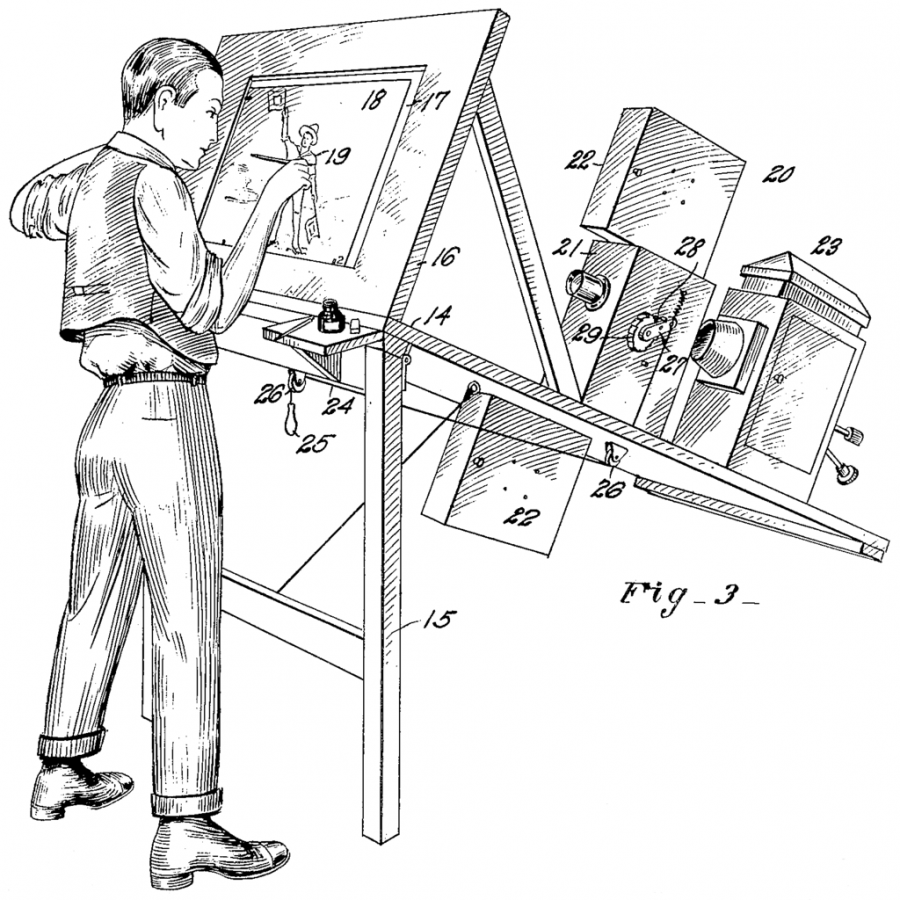The History of Modern Animation: A Profile of Max Fleisher and His Miracle Machine
The original patent drawing of the rotoscope from Fleischer’s patent, circa 1915.
Animation is one of the artforms that we take for granted. We treat it as something that has always existed. Yet, modern animation like the kind that we see in video games and on television is only about a hundred years old, and it all started with a New York animator named Max Fleisher and his miracle machine.
Before the creation of the rotoscope, animation was choppy, frame by frame, second by second, and it was often unsettling to watch given its choppy nature. A great example of this early style of animation is Pauvre Pierrot, a French film created by Charles-Émile Reynaud in 1892 . This short film was created with a machine called the praxinoscope, which used a spinning drum and several mirrors in order to create a rapid sequence of images that would imitate motion. Despite how rudimentary this device sounds, we must consider that prior to 1892, this was an enormous feat that would become the first-ever step towards modern animation.

The next step towards modern animation was taken by New York filmmaker J. Stuart Blackton and his animated movie in 1906, Humorous Phases of Funny Faces, the first-ever stop motion animation filmed on film stock, a medium in which film footage was stored. This signified the change from spinning photos and art to the use of mechanical film in animation. Yet, despite all of these steps towards what we know as animation today, the revolutionary device that would change animation forever was Max Fleischer’s rotoscope.
According to Fleischer studios, the rotoscope was created by Fleischer in 1914 with the idea of making the jerky and clunky films of early animation run more smoothly, but Fleischer achieved much more than just that. The rotoscope would be used to create many popular animations such as Popeye The Sailor and Snow White and the Seven Dwarfs. The machine would also be used for special effects in films such as Star Wars, helping to create the iconic color and glow of the lightsaber.
The Rotoscope also gave us the character known as Koko the Clown. Koko the Clown was the first semi-popular character that Max Fleischer would create, and it became an icon of Fleischer Studios. Koko was created by tracing over real-life footage of Fleischer’s brother; the character also helped give rise to Fleischer’s bouncing ball technique and the Song Car-Tune. The bouncing ball technique would become a popular method for singalongs and karaoke, and the Song Car-Tunes would become the first-ever animations to be synchronized with sound.
Despite the fact that Max Fleischer created one of the most important machines in animation history, his true claim to fame was the introduction of the character known as Betty Boop. Betty Boop is an icon of classic animation, first introduced in “Dizzy Wishes” as the love interest of Bimbo, another character of Fleischer Studios. However, she quickly overtook him in popularity, and soon received her own show, the eponymous Betty Boop. As time went on, she became one of the stars of Fleischer Studio sand is one of its the last few characters still remembered today.
Yet, it is not all peaches and roses for Betty, as she has faded into a form of obscurity in modern culture. In interviews conducted with several Bronx Science students, many had little to no knowledge of the character Betty Boop, with only one student even recognizing her in the famous animation, “Minnie the Moocher.”

His characters aside, Max Fleischer was a man who was crucial to the creation of animation as we know it today. Yet, his name seems to have faded following his passing in 1972. When I asked several Bronx Science students about Max Fleischer, only 1 person out of 10 could even recognize his name, with one student in the Class of 2024, stating, “It’s the general right?” confusing Max Fleischer with Carl Fleischer. And when asked who was the pioneer of animation, no one brought up the name Max Fleischer, with several students citing Walt Disney instead. It is time that we change that narrative. Let us make people hear and remember the name of Max Fleischer, the father of modern animation.
Tiankuo Zhang is an Editor-In-Chief for 'The Science Survey.' He sees journalism as something that has withstood the test of time and finds the transcriptions...

